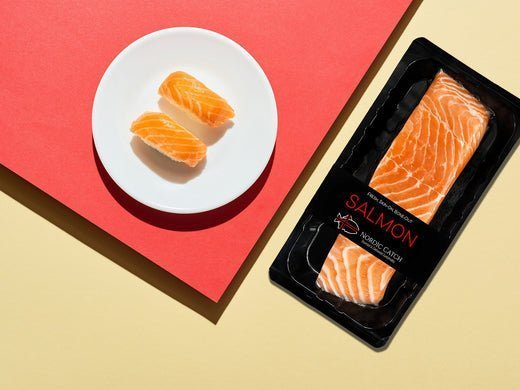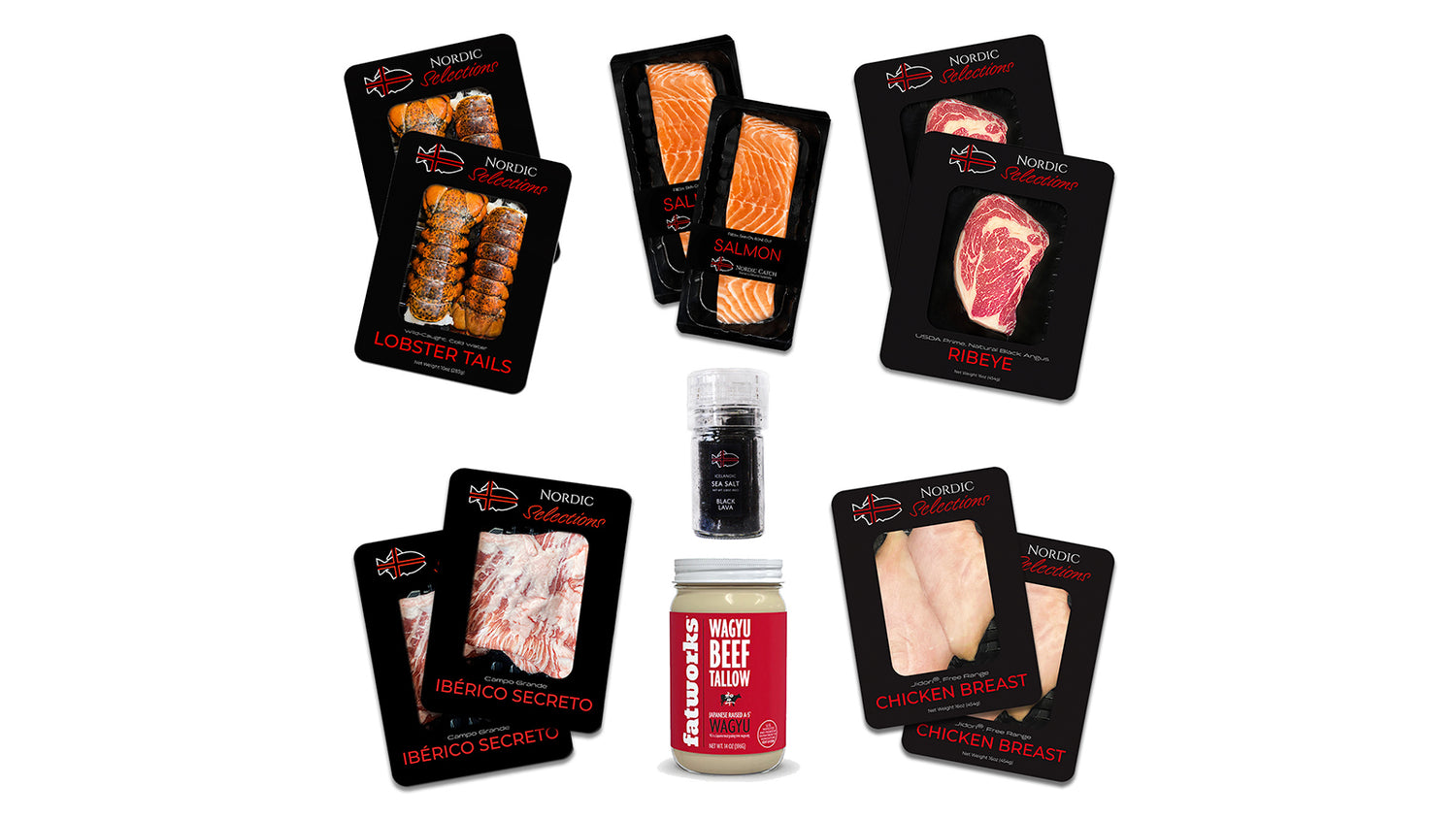
What is Sushi Grade Seafood?
When it comes to sushi, the quality of the seafood is of utmost importance. Sushi-grade seafood refers to the highest quality fish and seafood that is safe to be consumed raw. But what exactly does it mean?
What is sushi-grade seafood?
Sushi-grade seafood is fish and seafood that meets specific quality standards for raw consumption. These standards ensure that the seafood is safe to eat without cooking, as it undergoes a meticulous process of handling and inspection to minimize the risk of foodborne illnesses.
Many incorrectly believe that fish or other seafood must be frozen for seven days to be distinguished as sushi grade. This is only sometimes the case. Take Japan, for example, the birthplace of premium sushi. Itames, the distinguished master sushi chefs of Japan, don't use frozen fish—it's 100% fresh, caught the same day. At Nordic Catch, our seafood delivery service, we transport fish overnight to the United States from Iceland, fresh and never frozen—it's also sushi grade!
The belief that fish must be frozen for seven (7) days is essentially a marketing scheme to make consumers believe that they're buying a premium version of seafood when, in fact, it's been frozen for a week.
In simplest terms, sushi-grade fish is safe to eat raw and is high-quality and fresh. To determine whether or not it's sushi grade, you can investigate the storage and transportation methods, or if you have access to the entire fish, examine it yourself.
How to tell if fish is sushi-grade
You can quickly tell if seafood is sushi-grade with this quick checklist:
- Labels: Look for "sushi grade" or "sashimi grade" labels.
- Source: Buy from reputable fishmongers or specialty stores.
- Freshness: Check for clear eyes, red gills, firm flesh, and no slime.
- Smell: It should smell like clean seawater, not fishy.
- Handling: Verify proper storage on ice and sanitation.
- Species: Prefer commonly used sushi fish like tuna and salmon.
- Appearance: Look for vibrant color and firm, glossy flesh.
- Processing: Ask about the time from catch to processing and storage.
- Price: Higher quality fish is typically more expensive
If you want to prepare the highest-quality sushi or sashimi, checking every item on this list will ensure your safety and well-being.
What's so particular about sushi-grade seafood?
In addition to being the freshest, best-tasting seafood you can eat, sushi-grade seafood is the only fish you can safely consume raw. Safe from what, you ask? Parasites.
Parasitic organisms are a common concern in various types of meat, including seafood. Cooking kills parasites, but because sushi is served raw & uncooked, parasites are concerned about raw seafood.
There are millions of parasites, but when it comes to fish, just a few are worth mentioning: nematodes (also called cod worms), anisakis (or seal worms), and cestodes (tapeworms).
Nematodes are frequently present in white fish species, such as cod, haddock, and hake. This is why you'll rarely see white fish species on sushi menus. Anisakis can be found in species such as salmon, jacksmelt, and herring but are easily detectable and removed during processing.
Tapeworms are the most commonly known parasite among consumers, present in all types of food. In fish specifically, they're primarily associated with freshwater fish like wild trout and largemouth bass. It's strongly advised that you not consume freshwater fish in their raw state. Once cooked, they are safe to eat.
But if served raw, parasites are eliminated through one of three methods: resting the fish on a bed of ice, flash freezing, or traditional freezing.
Most raw seafood arrives to sushi chefs on a bed of ice, perfectly preserved from earlier that morning or the day prior.
Flash freezing, rapidly bringing the fish to extremely low temperatures, is particularly effective at killing parasites. The FDA recommends freezing fish at -4°F (-20°C) or below for a minimum of 7 days, or at -31°F (-35°C) or below until solid and storing at -31°F (-35°C) or below for 15 hours.
If freezing at colder temperatures, such as below -31°F (-35°C), the fish must remain frozen until solid, then stored at -4°F (-20°C) for 24 hours. These three methods kill parasites, ensuring the sushi or sashimi you consume is healthy and safe.
In any case, there are generally just a few fish species you'll see on a sushi menu that are safe to eat raw, assuming they pass quality & freshness standards.
The most popular seafood in sushi
Tuna (Maguro)
Varieties: Albacore, bigeye, bluefin, bonito, skipjack, and yellowfin.
Tuna, especially the fatty belly known as "toro," is highly prized in Japan. It symbolizes luxury and is often featured in high-end sushi restaurants. Tuna's rich, meaty flavor and firm texture make it a staple in sushi and sashimi dishes. It's also highly resistant to parasites, making it one of the safest fish to consume raw.
Salmon (Sake)
Although not traditionally used in Japanese sushi, salmon has become a global favorite due to its delicate flavor and buttery texture. It is often associated with modern sushi innovations in Japan and is particularly popular in Western-style sushi rolls.
Yellowtail (Hamachi)
Yellowtail, known for its gentle, buttery taste and firm texture, is a favorite in Japanese cuisine. It is often served as sashimi or in sushi, symbolizing freshness and quality. The best yellowtail, referred to as "buri," is highly valued, especially during the winter season when it is fattier.
Halibut (Hirame)
Halibut is revered for its subtle taste and delicate texture. In Japan, it is often one of the first dishes served in a sushi meal, signifying a gentle introduction to the dining experience. The finest halibut, "engawa," comes from the fin muscles and is considered a delicacy.
Mackerel (Saba)
Mackerel is known for its intense flavor and oily texture. In Japanese cuisine, it is often marinated in vinegar and salt to enhance its taste and preserve its freshness. Mackerel is a traditional ingredient in sushi, reflecting the Japanese emphasis on seasonal and regional ingredients.
Sea Urchin (Uni)
Sea urchin, with its creamy texture and salty flavor, is considered a delicacy in Japan. It is often a highlight in omakase (chef's choice) sushi menus, representing the pinnacle of freshness and luxury. Uni is prized for its unique taste and is often sourced from specific regions known for its high-quality sea urchins.
Eel (Unagi and Anago)
Eel is a beloved ingredient in Japanese cuisine, with freshwater eel (unagi) and saltwater eel (anago) both being popular. Unagi is typically grilled with a sweet soy-based sauce, while anago is often simmered. Eel dishes are enjoyed for their rich flavor and are traditionally eaten during the summer to provide stamina.
Squid (Ika)
Squid is valued for its chewy texture and mild flavor. In Japan, it is often served as sashimi or lightly grilled. Squid is a versatile ingredient that highlights the Japanese culinary technique of balancing textures and flavors.
Health Risks of Non-Sushi-Grade Seafood
Consuming non-sushi-grade seafood raw poses significant health risks due to the potential presence of parasites, bacteria, and viruses. Parasites can cause severe gastrointestinal issues and other health problems if ingested. For instance, anisakis can cause anisakiasis, leading to symptoms like abdominal pain, nausea, and vomiting.
Bacterial infections are another concern. Raw seafood can harbor bacteria like Vibrio parahaemolyticus, Salmonella, and Listeria monocytogenes, which can lead to foodborne illnesses with symptoms ranging from mild gastrointestinal distress to severe complications, especially in vulnerable populations such as the elderly, young children, pregnant women, and immunocompromised individuals.
Additionally, chemical contaminants, including heavy metals and marine biotoxins, can accumulate in fish tissues and pose long-term health risks. Regular consumption of contaminated raw fish can accumulate these toxins in the body, potentially causing chronic health issues.
Therefore, to minimize these health risks, ensuring that seafood intended for raw consumption meets stringent quality and safety standards is crucial. Nordic Catch seafood is farmed sustainably in Iceland and adheres to rigorous third-party testing.
Frequently Asked Questions
What is sushi-grade seafood?
Sushi-grade seafood is high-quality fish or seafood that's safe to eat raw due to careful handling and processing.
How can you tell if a fish is sushi grade?
You can tell if a fish is sushi-grade by checking its freshness, smell, and color and purchasing it from reputable sources specializing in sushi-grade products.
What is a safe seafood choice for sushi?
Tuna is generally considered one of the safest seafood choices for sushi due to its low parasite risk.

